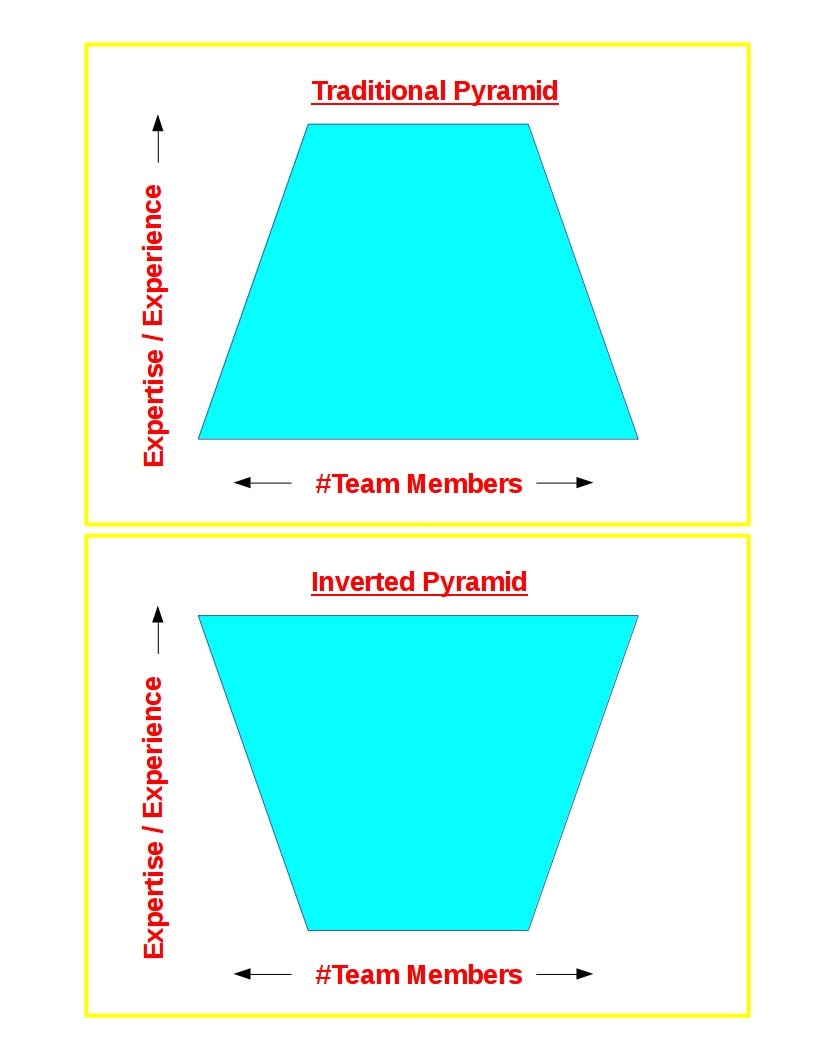Inverting the Pyramid
Indian IT industry is now more than 3 decades old. It has gone through multiple stages of evolution. The type of customers industry is working has been evolving, nature of work has changed, methodologies have come and gone. One aspect of the industry though has remained reasonably entrenched, what is popularly known as Pyramid(a trapezoid in reality) structure . At Dheeti Technologies we think it is about time we inverted the pyramid
What is this Pyramid?
The staffing mix of a typical IT Project or Product team today consists of -
A very small number of highly experienced , highly skilled people at top. A good percentage out of this small number consists of Line Managers(Around 10%). A slightly larger middle layer which has some people with line management responsibilities but most of them technical(Anything between 20 to 40%). A very large bottom layer which primarily consists of trainees,graduates fresh out of college, people with less than 5 years of experience.(50% or more)
This structure has served the industry well and there is a very successful business model built around it.At the same time there are several shortcomings of this model.
a. Majority of members of pyramid are less experienced & less skilled. They need
higher degree of supervision.More skilled members of team have to spend time in
training/managing less experienced people rather than focusing on problem
solving/solutioning.
b.Since majority of team is lacking in experience they
lack both in capability & confidence when it comes to decision making. Hence
decision making becomes slow and bureaucratic.
c. Small number of people at
top become bottleneck & knowledge hogs.
d.Younger, less experienced crowd
is also prone to more job changes/less stability. Since majority of team
consists of such people, there is a greater churn experienced overall
 Traditional Vs Inverted Pyramid
Traditional Vs Inverted Pyramid
While the IT companies developed,evolved internally, the external environment namely customer’s business environment & the nature of work has gone through a sea change.Agile, Devops, Analytics & Automation have been game changers. All these have few common characteristics
a. They demand high level of skill.
b. They demand ability to anticipate,
learn & adapt rapidly
c. They demand ability to work independently with
minimum supervision
The pyramid structure does not respond well to these characteristics.
At Dheeti we believe inverting the pyramid is the right way to address these challenges. Our teams are structured such that they consist of highly skilled highly experienced individuals in majority, a very small number of less experienced yet sharp engineers & no line management. This leads to
a. Higher level of maturity & more decisive team.
b. Near zero management
layer.
c. Less time spent on training and retraining
d. More stability
less churn
e. Less chance of 1 person or small number of people becoming
bottlenecks/knowledge hogs
While having a “top heavy” pyramid means the cost is higher per team member, given the benefits in productivity, thinner line management, lesser churn & higher cohesion, total cost of delivery remains comparable with significant gains in quality
What about Scaling?
In addition to cost, one of the reasons why organizations traditionally went for a pyramid was for scalability. It is hard to find skilled & experienced people in same numbers as less experienced ones. To scale rapidly, one needs to hire fast. This can be challenging as the population of highly experienced people is much smaller.
This argument had lot more substance to it in early 1990s when industry was still in infancy & the population of people working itself was small. Now after 2 decades this is not true. There is greater availability of experienced people simply because of the time that has elapsed.
Additionally many people who are interested in remaining in technical career path are forced into managerial roles because of Pyramid structure.This group finds the inverted pyramid attractive.
As has been often seen with higher levels of skill & maturity you can get same throughput but with less number of people. Often this downscaling is not linear as along with smaller size, the overheads of scale also go down. Additionally with lower levels of attrition there is lesser churn, lesser number of role replacements are needed.
There will always be some areas where sheer numbers to do repetitive tasks with little variation are required. Inverted Pyramid is an overkill & is not the right solution in such scenario.